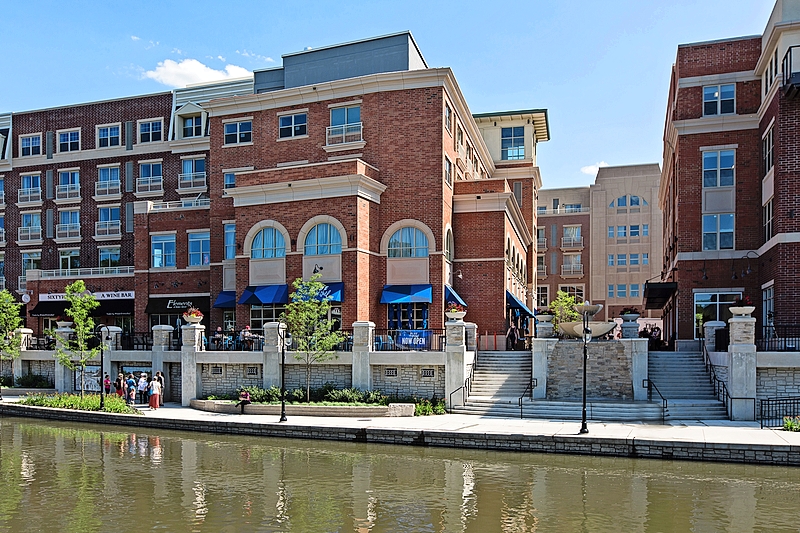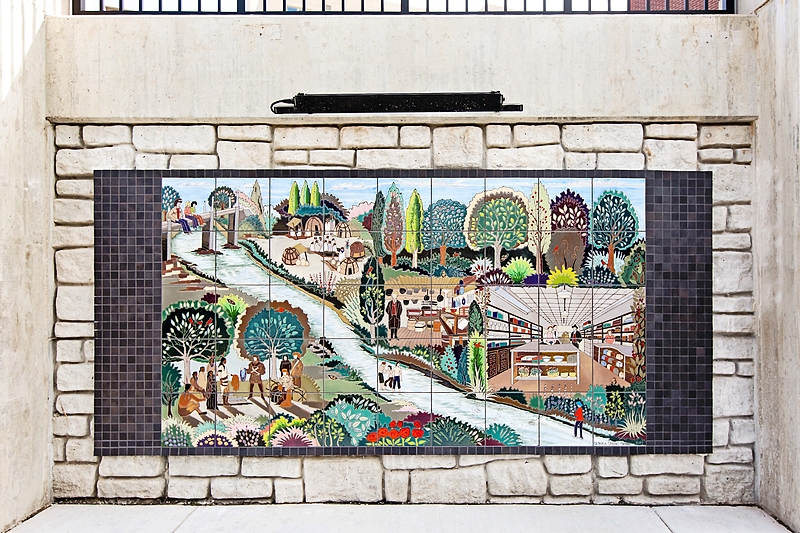River City Revival
By Michelle Dellinger
August 2017 View more Featured
It took Nick Ryan and his dedicated team fifteen years to develop Water Street and erect a boutique hotel on the Riverwalk. Meet the tenacious influencers who pulled off a $93 million win for the city.

Watching Nick Ryan walk down Water Street is comparable to seeing a celebrity greet adoring fans—the shop owners, tradesmen and Marquette employees who congregate within downtown Naperville’s newest enclave greet their leader with absolute devotion. People flock to wave and high-five Ryan as he strolls the block he built, and the pride on his face is contagious.
This beloved man is the CEO of Marquette Companies, the billion-dollar real-estate firm that recently moved its sleek headquarters into one of several new buildings that line Water Street between Webster and Main. The project’s scale is among Marquette’s top three developments in the country. Only two multi-use (residential, commercial and retail) developments in Chicago and Houston—urban populations of over two million—are larger than Naperville’s Water Street.
Those who have supported Ryan’s dream development also know of the unflappable dedication it took to complete the project that almost wasn’t. Ryan and his investors accomplished nothing short of a miracle when they persevered through a decade of municipal stalls, compromises and reconfigurations.
It was never disputed that Water Street needed a makeover. “From my perspective,” says Mayor Steve Chirico, “it was about improving an area that needed to be improved. We knew it was going to have a halo effect and drive business to all of our downtown businesses. Cities don’t get projects like this very often.” But the size, scope and direction of the mixed-use space on Water Street changed drastically over the past decade.
Marquette began assembling eleven parcels of land along the river between 2005 and 2006, and the first proposal to reach city council—which was passed 8 to 1 in 2007—called for retail space with high-end condominiums. “And then the market tanked,” shares Ryan, who put the project on hold when the condo market died. But the setback was fortuitous, as was a personal stay at Hotel Baker in St. Charles. When Ryan and his wife Teresa, managing broker/owner of Ryan Hill Realty, realized the hotel property was along the river, the idea struck: replace the condos with a boutique hotel.
Ryan’s people ran the numbers and decided it would work if another floor was added to achieve adequate square footage, but that’s when public outcry ensued. Although there are taller buildings downtown (namely the condos at 520 South Washington and 509 Aurora Avenue), opposition was fierce. “Height and bulk were always in the forefront,” says the city’s Bill Novak. “We went before the council too many times to remember. It did not look pretty there for a while.”
But Ryan and his investors were motivated by their unique opportunity to develop a full city block and the impact it could have on the community. They poured millions of additional capital, priceless emotional dedication and tireless effort into accommodating concerns and building consensus for the next few years.
Despite the negative feedback, Ryan’s resolve never wavered. “People like Nick have a vision,” says Chirico, “and it takes those types of visionaries to have the resources, commitment and dedication to get a project of this size done.” Chirico worked with Marquette to find remedies for the concerns to move the needle. He and former Mayor Pradel were two of the project’s staunch supporters.
Ultimately the success of the Water Street development was contingent upon building alliances. “When you’re planning something of this magnitude,” Ryan says, “relationships are especially important.” Meetings were arranged with each councilperson to ascertain concerns, and three public hearings were held. Deborah Newman took on a majority of the community relations work; she personally analyzed more than 250 comment cards received at the hearings. “No one thought this was going to happen,” says Newman, “but Nick truly believed it was a good thing for the community.”
One of the last challenges addressed involved the Elements banquet facility. “Parking was a real concern,” Novak says. “We came up with a plan to identify valet parking areas for events over a certain number of people.” Ultimately the reduction of the building height by six feet and offsite parking arrangements—along with myriad of parking, tenant, Riverwalk and mechanical adjustments—gave Marquette the consensus it needed. In November 2014 city council approved development of the 2.4-acre site to include shops, restaurants, a boutique hotel, plaza and parking garage. After thirteen years of planning and concessions, building could begin.
Construction project managers Jeff Prosapio and Randy Selvaggio then took the reins, and a groundbreaking event was scheduled just two weeks before Mayor Pradel retired. “I’m proud of Naperville,” Pradel said at the ceremony. “Thanks for being here to witness a new transformation.”
One of the logistical challenges after demolition was that existing utility connections were outdated and had to be replaced. “We started from scratch,” Selvaggio says. “Demo and all-new buildings. Electric, water, sewer, the whole shot.” He also had to work side-by-side with homeowners and commercial space owners on Aurora Avenue to reconnect the block. And utilities weren’t the only construction problem—the development brought with it a complicated engineering challenge because of its proximity to the river.
“We demolished a structure that was impervious, improved the storm sewer system and created a holding tank,” explains Prosapio, adding that “responsible development adds benefit to a site.” A huge water storage vault now sits under Water Street. If the DuPage River rises high enough, spill-over openings provide storm water relief, then slowly release water back into the river.
Selvaggio’s thoughts on Water Street are both vocational and personal. In the middle of the project he had triple-bypass surgery and had to leave the site for eleven weeks. “When I came back, they wanted me back on the project,” he says. “That is part of my love story with Water Street. They were there for me all the time.”
Similar praise for Ryan and Marquette is unanimous. Novak admits that in his role with the city, “I’ve seen projects that succeeded, and I’ve seen projects that failed. Ryan is an unbelievably positive person who never lost his can-do spirit. He came in and said, ‘We’re going to figure out how to make this happen.’”
Today, Water Street is anchored by Hotel Indigo, has a busy wedding and banquet facility called Elements and a second-story skybridge connecting rooms on both sides of the street. Two out of five planned restaurants have opened, Blue Sushi Sake Grill and SixtyFour–A Wine Bar, as well as the clothing shop Southern Tide. A 521-space garage has increased downtown parking options and several more shops and office spaces are yet to come.
After more than a decade of effort, Team Water Street certainly has much to celebrate. At the dedication ceremony in June, Ryan greeted guests and offered a fitting summary of his legacy project: “Welcome to wonderful Water Street. What a wonderful place to live, work and play we have created here together.”

Streaming History
The Water Street development includes five, five-by-nine-foot porcelain murals depicting historic scenes along the DuPage River, Water Street, Central Park and downtown Naperville. Developer Nick Ryan met Santa Fe artist Debora Duran-Geiger at the Riverwalk Art Fair in Naperville, the community in which her husband had lived as a boy. The “Streaming History” series, commissioned by Deborah Newman on behalf of Marquette, includes the following murals:
- “Harvest Time,” a view of the DuPage River from the Main Street bridge, looking east over farm fields and a barn; donated by Dominick Imburgia
- “Winter on the River,” which showcases ice harvesting and residents skating on the DuPage River; donated by Nick and Teresa Ryan
- “Water Street Yesterdays,” featuring three Water Street structures like the Kelsch family home, as well as former Mayor Pradel as a young man washing his car; donated by the Dave Kelsch Family
- “Immigration Celebration,” which depicts Cuban-born parents overlooking a Central Park gathering of many nineteenth- and twentieth-century immigrants; donated by Peter Foyo
- “Commerce Comes Alive” illustrates commercial ventures in Naperville from the first traders through to Sam Rubin’s department store; donated by the Rubin Family.


